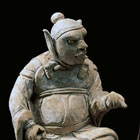J.J. Lally & Co., Oriental Art / New York City, New York
MenuPast Exhibition
Ancient Chinese Tomb Sculpture
March 22 - April 10, 2004
13.
A GROUP OF FIVE RED POTTERY WARRIOR DEITIES
Song Dynasty (A.D. 960-1279)
separately modelled, seated on open rockwork thrones, wearing differently detailed leather helmets and armored tunics hung from buckled straps across the shoulders, with long robes over their legs and heavy boots on their feet, their faces freely carved with expressive 'foreign' features including aquiline noses and bushy eyebrows, their heads turned and their bodies differently posed as if engaged in an animated debate, modelled fully in the round, all with segmented belts showing at the back, several with stamped ring and florette motifs on the back, and one wearing linked armor, all made from orangey-red pottery showing remains of chalk-white pigment and some encrusted earth, with a few traces of accidental touches of green glaze, the red clay and the informal sculptural style characteristic of tomb sculptures found in Sichuan province.
Heights 7 5⁄8 inches - 8 1⁄8 inches (19.3 cm - 20.6 cm)
It has been suggested that these five pottery figures might represent the Wudaoshen, Spirits of the Five Paths or the Five Destinies of the human soul in the Buddhist doctrine. These deities were responsible for overseeing the five possible rebirths: 1) in the hells, 2) as a hungry ghost, 3) as an animal, 4) as a human, or 5) as a deva. Although the Wudaoshen were usually described as judges, an early Buddhist text in the 4th century describes them as military figures.
Compare the warrior deities with similar helmets and armor carved on the stone walls of the tomb of Du Guang Shi and his wife, excavated in 1980 at Guanyuan, Sichuan province and dated to A.D. 1195 by deeds for the burial ground found in the tomb, illustrated in Wenwu, 1982, No. 6, p. 57, figs. 19 and 20, and with line drawings on p. 55, figs. 6-9. Buddhist ritual images including a stone carving of a lady, with a Buddhist rosary in her hand as if chanting and praying, with two attendants on either side, were found in the same tomb.
Compare also the similarly modelled partially glazed red pottery standing figure dressed in an armored tunic, wearing a similar helmet and holding an axe, excavated in 1986 from the Northern Song tomb of Zhang Que and his wife, with an epitaph dated to A.D. 1093, discovered in the eastern outskirts of Chengdu, Sichuan province, illustrated in Wenwu, 1990, No. 3, pl. 1, fig. 1 and p. 3, fig. 2.
